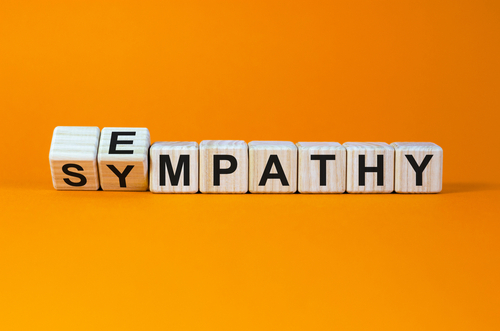The idea that employers should empathize with their workers is relatively new. Just ask Bob Cratchit how empathetic his employer, Mr. Scrooge, was in Victorian-era England. Of course, by the end of the Charles Dickens classic A Christmas Tale, and thanks to some supernatural intervention, Scrooge came around and developed genuine sympathy for the plight of the Cratchit family.
But sympathy is not the same as empathy.
Sympathy Isn’t the Same as Empathy
Consider the definitions of these words from Merriam-Webster:
Sympathy: “the feeling that you care about and are sorry about someone else’s trouble, grief, misfortune, etc.”
Empathy: “the action of understanding, being aware of, being sensitive to, and vicariously experiencing the feelings, thoughts, and experience of another of either the past or present without having the feelings, thoughts, and experience fully communicated in an objectively explicit manner.”
Hopefully, a few points stand out in comparing these definitions. First, sympathy is defined as a “feeling,” whereas empathy is defined as an “action.” Second, sympathy is caring about or being sorry about someone else’s misfortune; empathy is deeper—understanding and vicariously experiencing another’s feelings.
Empathy Matters
Empathy is important in the employer-employee context because it better motivates concrete action and changes in policies. An employer that knows what it’s like to struggle to afford child care is more likely to offer employer-sponsored, on-site day care than an employer that simply “feels sorry” for workers struggling to pay for child care.
Unfortunately for employees, the gap between the employer and the employee is so far apart in many organizations that genuine empathy may not often occur naturally. A millionaire CEO will likely find it difficult to genuinely empathize with an entry-level employee worrying about medical bills, for example.
A Look at “Radical Empathy”
This is where the concept of “radical empathy” comes in. Radical empathy involves actively putting yourself in others’ shoes you’d like to empathize with—to the extent reasonably possible. In an article for Fortune, Nicole Goodkind gives an example of a radical empathy exercise designed to put corporate leaders in the shoes of visually impaired employees:
Early on Monday evening about 30 of the world’s most powerful business leaders sat blindfolded together in the lower levels of a swanky Washington D.C. hotel.
No, this wasn’t a hostage situation. It was an exercise in radical empathy, individual empowerment, and inclusion held at the Fortune CEO Initiative.
Led by Sara Minkara, the U.S. Special Advisor on International Disability Rights under President Joe Biden, the group of executives entered the room blindfolded and were led through a series of exercises where they were asked to talk to one another without revealing their official titles.
Radical empathy may sound, well, radical, but the trend illustrates both the importance and the challenge of creating genuine empathy toward employees in order to drive meaningful discussion and change.
How might you incorporate radical empathy into your organization to build better understanding among employees?
Lin Grensing-Pophal is a Contributing Editor at HR Daily Advisor.

